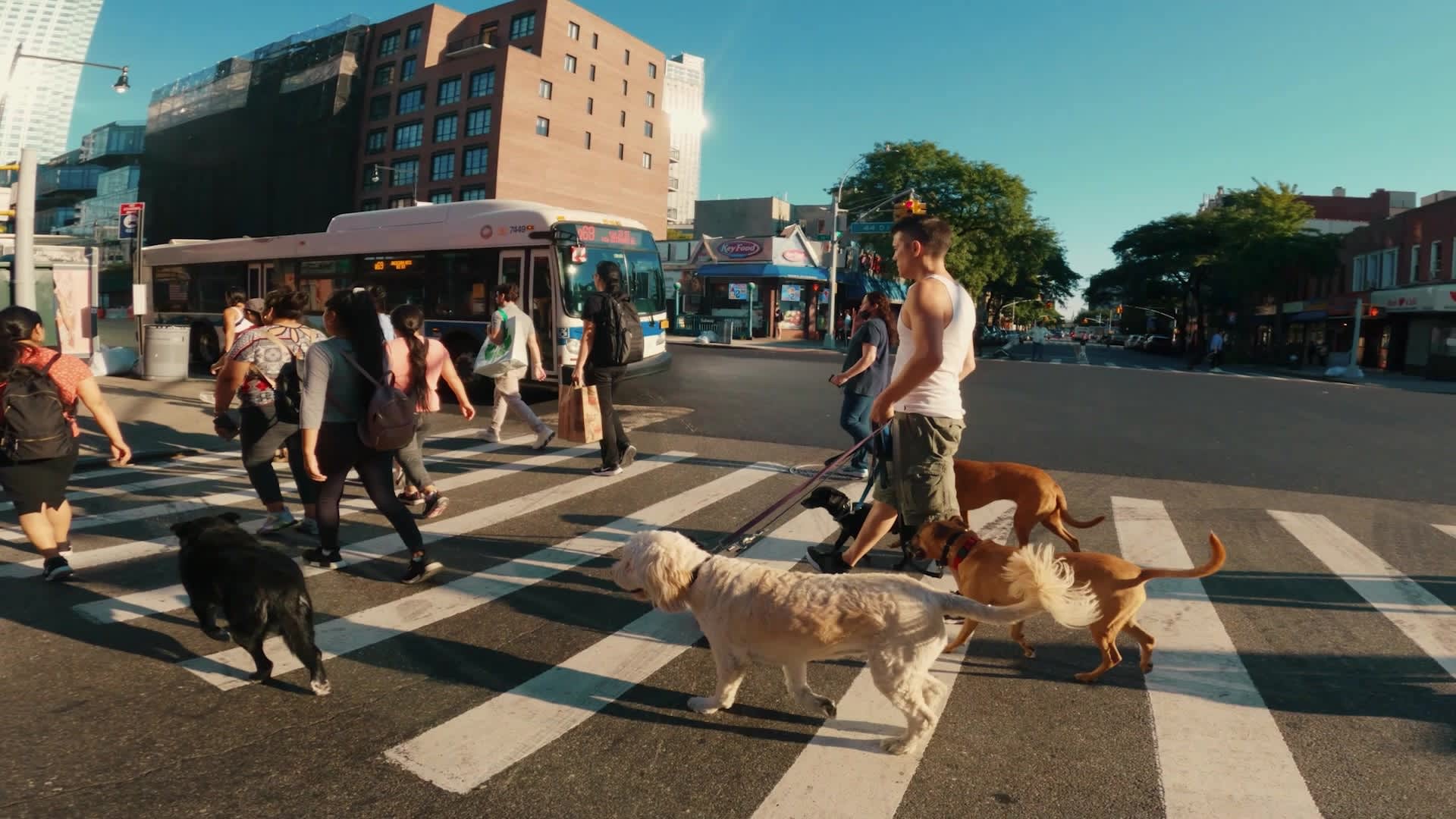
After 20 years in the dog-walking business, Ryan Stewart says he isn't just a dog person — he sees himself as one of the pack.
Stewart started his New York side hustle, Ryan for Dogs, in 2002 to earn money between sparse acting gigs. Now, it's his full-time job: He makes roughly $60 per hour walking three to five pups at a time. Guaranteed work by a reputation built over multiple decades, Stewart makes up to $120,000 per year, according to documents reviewed by CNBC Make It.
"I don't even think of myself as loving dogs, it's just that they're almost like an extension," Stewart tells CNBC Make It. "I don't love my right hand, you know? It's just there."
Stewart, who declined to disclose his age, adds that the best part of his job is that "without a college degree, I've managed to make six figures a year ... doing something I love." He works roughly 36 hours per week, spread across six days, he says — noting that dogs require constant attention, making his six-hour shifts often feel demanding.
Get New England news, weather forecasts and entertainment stories to your inbox. Sign up for NECN newsletters.
"A good dog walker is focused and attentive, because you want to prevent your dog from getting hurt," Stewart says. "You have to watch traffic. You have to watch the dogs [so they] don't fight each other. It's not one of those [jobs] that you can put on some AirPods and listen to music while you're doing it."
Mistakes in his field are costly, Stewart says. Small lapses in focus could lead to a dog's tail getting caught in a door, potentially leading to a $2,000 vet bill.
But the benefits of spending his days with dogs, he says, outweigh the cons. Here's how he channeled his connection with dogs into a fulfilling and lucrative day job:
Money Report
A long road to lucrative
Growing up, Stewart's siblings mowed the lawn and set the dinner table. His chore was walking the family's dogs. So, when he started pursuing professional dancing in New York in his 20s, he thought dog-walking could be a natural side hustle.
"I remember standing on the street handing out business cards," Stewart says. "I just started out with like one or two dogs [for] half a year, before that became three or four."
After a couple of years, Stewart realized dog-walking could become more lucrative if it was his sole focus. But it would be a long road to get there: Despite high demand in large cities, the average dog walker in New York makes $35,625 per year, according to ZipRecruiter.

Today, Stewart says he's able to make more because people know his reputation: He charges about $20 to $25 for each dog on a group walk. Roughly half of his clients are from referrals, with the other half coming from applications submitted on his website.
Those applications can pile up. Stewart says he's selective about the types of dogs and owners he works with, and only responds to 10% of the requests he receives on his website.
"I don't [want] to go back to the owner and say, 'I don't want to walk your dog anymore,'" he says. "If you annoy them, maybe they'll write a bad review."
Learning by trial and error
Stewart's schedule on weekdays includes two to three hours of walks in the morning, a break to hydrate and nap, then another two-to-three-hour evening shift. On Saturdays, he works one to two hours. He takes almost every Sunday off.
Stewart has strict rules for the road when it comes to his business. He always uses his own equipment, including four-foot leashes and collars — never harnesses.
"I like to have control of the dog's head," he says. "If you have a dog on a harness and there's a chicken bone there and the dog tries to get it, the harness isn't very effective to keep the head from ducking down and snatching it, but a collar will prevent the dog from doing it."
Stewart says he does "group walks" because he feels it's better for the dogs to interact with one another. He occasionally walks some dogs off-leash, he adds: Sometimes it alarms the owners, but Stewart says he can tell which dogs are better at paying attention, and in 20 years, he's never had a dog run over by a car.
Some of Stewart's methods might perplex dog owners, but he insists he's learned from trial and error. He explains to each owner that his methods ultimately keep the dogs safer, part of why he's built a strong reputation.
Pros and cons to the dog-walking job
The job has multiple drawbacks, Stewart says. He pays for his own health insurance, doesn't get paid vacations and picks up a lot of poop.
The most challenging parts of his job involve dealing with dog owners. he adds: Especially since the Covid-19 pandemic hit, his clients have upped their expectations. Many owners text Stewart to check in during walks, which is his pet peeve — a distraction, when he should be focused on the dogs.
"Owners are increasingly more demanding and crazier," he says. "There's more cameras and there's more dog trackers. That's a challenge because you feel have people looking over your shoulder all the time. It just makes it more stressful."

Still, he says, the pandemic has given the pet industry a huge boost: The more time you spend around your pets, the more likely you are to spend money on them. And since many dog owners are still tied to their laptops, even if they're technically at home on weekdays, they might need a dog walker.
In 2019, the pet industry was worth $97.1 billion, according to American Pet Products Association. In 2021, it skyrocketed to $123.6 billion.
"I think the pet industry is a growing business because we don't belong to groups as much as we used to," Stewart says. "We don't belong to book clubs or bowling leagues or knitting circles ... People stay home more, so where do they put their affection and their need to touch? They do it with their cats and dogs."
Correction: This story has been updated to reflect that Stewart declined to disclose his age.
Sign up now: Get smarter about your money and career with our weekly newsletter
Don't miss:
Having a pet could help you stay sharper as you age, according to a new study — here’s how
This 35-year-old spends $55 a month photoshopping dogs—and has made $100,000 in just half a year






